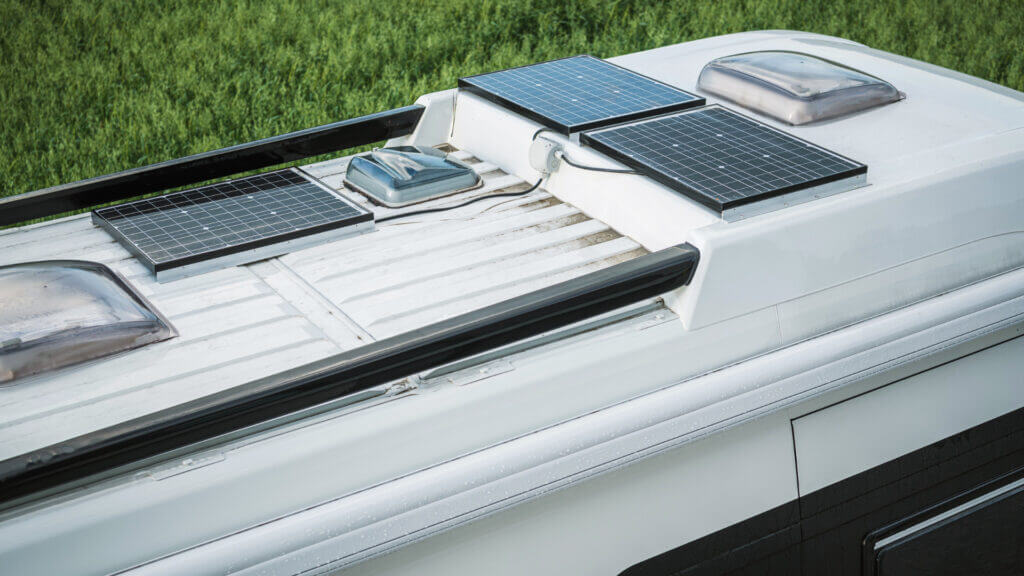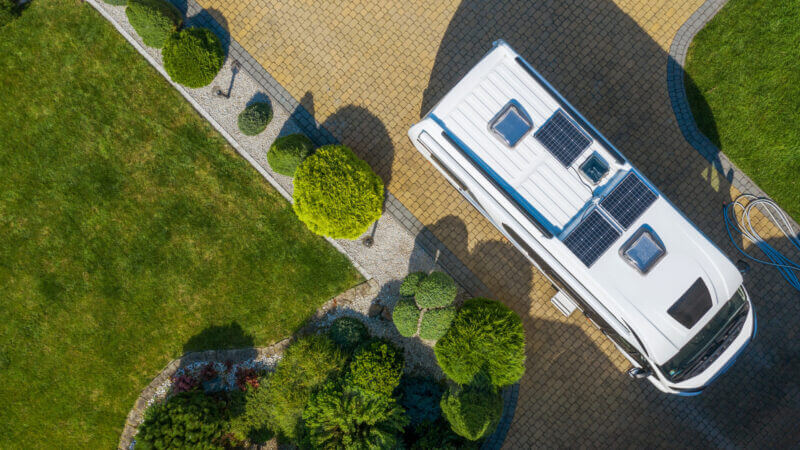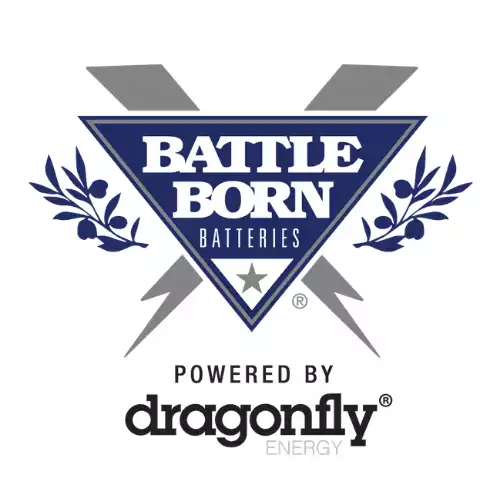Table of Contents Show
How many solar panels do I need for my RV? Well, that’s a good question.
If you love to boondock as we do, it doesn’t take long to realize that solar power is a great option. It allows you to remain off-grid for extended periods. It also allows you to do so without using a noisy generator much or even at all.
Realizing that solar power is a great option and understanding how to implement it are two different things. The overall idea isn’t all that difficult. The number of solar panels you need for your RV essentially comes down to how many batteries you need to charge.
There are different ways to figure this out. We’re here to make it easier and guide you through the process.

Power Used: How Much Power Do I Need for Camping?
Method 1: Do the Math
The first method requires a lot of calculations. You’ll need to know all of the various appliances, devices, and control panels that use power while you’re camping. You also need to know how much you use those items daily.
You’ll then do a bunch of calculations to determine just how much power all of those items use combined. You’ll convert this number in watts. Now, you know how much battery capacity you require and how many solar panels you need.
There are numerous online resources to give you estimates. There are also many easy to overlook items that can throw off your calculations. We typically find it easier and more realistic to use a real-life scenario: the camping test.
Method 2: The Camping Test
The second method for determining how many solar panels you need for your RV is based more on real-world activity. Simply go camping.
Okay, it’s not that simple, but it is not very difficult. Even with one or two batteries, you can do the camping test to determine how many solar panels you require to meet your RVing needs.
If you have 200 amp hours of lead-acid batteries, you have about 100 amp-hours of usable capacity. (Remember: you should never drain lead-acid batteries below 50-percent, or they can be irreversibly damaged.)
Head out in your camper with a full charge on your batteries (check the levels with a multimeter that can read the voltage). Use them as you normally would, so you get a true test of how much power you need. If your batteries last two days, you have essentially used 50 amp-hours per day.
From this test, you can determine that you need enough solar panels to charge at least 50 amp-hours per day to avoid depleting your battery storage. In this case, that would mean at least two 100-watt solar panels. (2 panels x 30 amp-hours each = 60 amp hours)
If you can’t get through a single day without depleting your batteries, consider adding more batteries to your bank. The sun won’t always be shining, so you’ll probably want more storage capacity than you typically use in a day. We recommend having two to three days’ worth of power.
Lithium batteries are the easiest way to achieve that goal as you get more power storage in less space and weight.
Battle Born Batteries offers a full line of lithium-ion batteries. Whether you simply want a drop-in replacement for your current battery or want a reliable off-grid system for some serious boondocking, they have you covered. We've used and abused our Battle Born Batteries for years and can confidently say lead is dead.
Tips for Estimating RV Solar Panel Needs
The general rule of thumb is that a 100-watt solar panel can produce a maximum of about 30 amp-hours per day. By knowing this, we can start to estimate battery capacity vs. solar panels.
Match your battery capacity in amp-hours with your solar output in watts.
For example, if you have 100 amp-hours of battery capacity, you’ll want at least 300 watts of solar panels.
Energy-Saving Tips
Even if you have the perfect number of solar panels for your RV, the world isn’t perfect. Those aforementioned cloudy days will hamper your solar power recharging.
Fortunately, there are many ways to cut down on how much energy you use.
One of our best finds is replacing standard bulbs throughout your RV with LED bulbs. This process has never been easier. You can find LED bulbs for nearly any application, reducing your energy usage and the heat generated to a fraction of standard bulbs.
Another overlooked tip is simply unplugging electronics when they’re not in use. It’s easy to forget that you left a phone, tablet, or other electronic device plugged in, which can sap energy even when the device is fully charged. You can also charge devices while you’re driving with a simple, affordable 12-volt adapter.
You can also change up your habits to cut down on energy usage. Maybe try reading more during the daytime than at night. Get out and about during the day instead of turning on a fan or air conditioning. Use an extra blanket at night.
It’s also a good idea to replace inefficient older devices with energy-saving newer devices. Items like TVs have gotten much more energy-efficient, not to mention that LED flat screens take up less space than ever. Or use a pour-over to make your coffee in the morning instead of an automated coffee maker, doing away with the power-sucking device altogether.
Things to Consider with Roof Mounted Panels
There are lots of solar panel options on the market. The traditional roof-mounted option sounds decent because it’s simple to install, and you’ve instantly got solar power, right? Wrong.
There are a few things to consider when it comes to roof-mounted solar panels for your RV:
The panels aren’t very efficient if you don’t aim them. You have to tilt them for full sun exposure and maximum effect, so you’ll either have to climb on the roof and tilt them by hand, or pay for an option to automate the process. By contrast, mobile options that you set up on the ground are easily tilted by hand.
You also have to move the RV itself to optimize the panels in relation to what direction the sun is shining. That can be a pain in any rig, which is particularly true if you have a Class A, travel trailer, or fifth wheel. You can move mobile panels by hand.
Another thing that can hamper roof-mounted solar panels is forgetting to clean them. To reach maximum efficiency, you must clean your solar panels regularly. Again, you’ll have to climb on the roof to accomplish this task. Or you can go the mobile route, where you can clean them while safely standing on the ground.
You don’t have to avoid flexible roof-mounted solar panels when considering solar power options for your RV, but you need to know the risks and rewards of both options.
By offering the methods above and our energy-saving tips, we aim to help you get the most out of your boondocking experiences.
Whether you go with roof-mounted or mobile options, hopefully, you can now adequately answer the question, “How many solar panels do I need for my RV?”








Our process was different. We did a rough estimate of a high draw situation like what would it take to run the furnace all night and then make coffee and run a blow dryer in the morning. From there it was a budget vs space/weight issue. We went with 3 x 390 watt panels on the roof and 3 Battleborn batteries. We used all Victron chargers and 3KW hybrid inverter. The system was installed by Northern Arizona Wind and Sun in one evening. Very happy with quality and performance.
An RV friend has solved the dilemma of solar panel placement. Hers are mounted on clips on the RV roof thus allowing charging while underway. When parked in a shady area, she removes and deploys the panels in the sun.